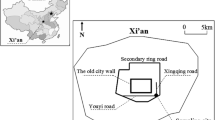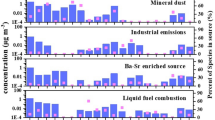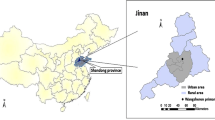Abstract
To clarify the pollution sources of heavy metals in PM2.5 and the health risks posed by them in heating and non-heating seasons, 42 samples were collected in 2017 and 2018 in Taiyuan and Yuci college town, China. Elemental analysis of the PM2.5 samples through acid-dissolved plasma mass spectrometry was performed to determine the concentrations of 10 elements (As, Cd, Co, Cr, Cu, Mn, Ni, Pb, V, and Zn). We determined the types of pollution sources by enrichment factor (EF) and principal component analysis (PCA). We performed a health risk assessment based on the US Environmental Protection Agency (EPA) guidelines and the database of the International Agency for Research on Cancer (IARC) to assess both carcinogenic and non-carcinogenic risks of the heavy metals to adults and children. The results indicate that the EF values of all 10 elements were greater than 1, suggesting anthropogenic sources in both heating and non-heating seasons. PCA revealed that the three main components were soot dust, metal smelting emission, and industrial dust. Regarding the health risks caused by the heavy metals, children were more susceptible to non-carcinogenic risks than adults, and people faced higher non-carcinogenic risks during the heating season. For carcinogenic risk, Cr has the highest risk coefficient (1.68 × 10−4), higher than the US EPA’s threshold (1.00 × 10−6). People were exposed to carcinogenic risk. The study explored specific pollution sources and explained their effect on health to assist with the development of prevention and control measures.




Similar content being viewed by others
References
Ali N, Adil I, Magsi A, Asif E (2020) Particle size, morphology and characterization of indoor and outdoor airborne particulate matter for toxic metals in Karachi [J]. Int J Environ Sci Technol
Anderson JO, Thundiyil JG, Stolbach A (2012) Clearing the air: a review of the effects of particulate matter air pollution on human health. J Med Toxicol 8:166–175
Apeagyei E, Bank MS, Spengler JD (2011) Distribution of heavy metals in road dust along an urban-rural gradient in Massachusetts. Atmos Environ 45:2310–2323
Apte JS, Marshall JD, Cohen AJ, Brauer M (2015) Addressing global mortality from ambient PM2.5. Environ Sci Technol 49:8057–8066
Brunekreef B, Holgate ST (2002) Air pollution and health. Lancet (London, England) 360:1233–1242
Chalvatzaki E, Chatoutsidou SE, Lehtomaki H, Almeida SM, Eleftheriadis K, Hanninen O, Lazaridis M (2019) Characterization of human health risks from particulate air pollution in selected European cities. Atmosphere 10:16
Chen J, Tan M, Li Y, Zheng J, Zhang Y, Shan Z, Zhang G, Li Y (2008) Characteristics of trace elements and lead isotope ratios in PM2.5 from four sites in Shanghai. J Hazard Mater 156:36–43
Chen P, Bi X, Zhang J, Wu J, Feng Y (2015) Assessment of heavy metal pollution characteristics and human health risk of exposure to ambient PM2.5 in Tianjin, China. Particuology 20:104–109
Chen J, Lu J, Ning J, Yan Y, Li S, Zhou L (2019) Pollution characteristics, sources, and risk assessment of heavy metals and perfluorinated compounds in PM2.5 in the major industrial city of Northern Xinjiang, China. Air Qual Atmos Health 12:909–918
CNEMC (1990) Cnemc (China National Environmental Monitoring Center). Background values of soil elements in China. Environmental Science Press, Beijing (in Chinese)
Croitoru L, Sarraf M (2017) Estimating the Health Cost of Air Pollution: The Case of Morocco. J Environ Prot 08:1087–1099
Dai QL (2015) Characterization and source identification of heavy metals in ambient PM10 and PM2.5 in an integrated iron and steel industry zone compared with a background site. Aerosol Air Qual Res 15:875–887
Du LL, Wang Y, Wu ZC, Hou CX, Mao HT, Li T, Nie XL (2019) PM2.5-bound toxic elements in an urban city in East China: concentrations, sources, and health risks. Int J Environ Res Public Health 16:13
Duan JC, Tan JH (2013) Atmospheric heavy metals and arsenic in China: situation, sources and control policies. Atmos Environ 74:93–101
Feng L (2003) Principal component analysis of environmental quality. Math Pract Theor 33:32–35 (in Chinese)
Harb MK, Ebqa'ai M, Al-Rashidi A et al (2015) Investigation of selected heavy metals in street and house dust from Al-Qunfudah, Kingdom of Saudi Arabia [J]. Environ Earth Sci 74(2):1755–1763
Hsu CY, Chiang HC, Lin SL, Chen MJ, Lin TY, Chen YC (2016) Elemental characterization and source apportionment of PM10 and PM2.5 in the western coastal area of central Taiwan. Sci Total Environ 541:1139–1150
Hu X, Zhang Y, Ding ZH, Wang TJ, Lian HZ, Sun YY, Wu J, Lt (2012) Bioaccessibility and health risk of arsenic and heavy metals (Cd, Co, Cr, Cu, Ni, Pb, Zn and Mn) in TSP and PM2.5 in Nanjing, China. Atmos Environ 57:146–152
IARC (2019) Agents classified by the Iarc Monographs. Int J Environ Res Public Health:1–123
Johansson C, Norman M, Gidhagen L (2007) Spatial & temporal variations of PM10 and particle number concentrations in urban air. Environ Monit Assess 127:477–487
Kadi MW (2009) “Soil pollution hazardous to environment”: a case study on the chemical composition and correlation to automobile traffic of the roadside soil of Jeddah city, Saudi Arabia [J]. J Hazard Mater 168(2):1280–1283
Khodeir M, Shamy M, Alghamdi M, Zhong M, Sun H, Costa M, Chen LC, Maciejczyk P (2012) Source apportionment and elemental composition of PM2.5 and PM10 in Jeddah City, Saudi Arabia. Atmospheric Pollution Research 3:331–340
Künzli N (2000) Public-Health Impact of Outdoor and Traffic-Related Air Pollution: A European Assessment. Lancet (London, England):9232
Li LJ, Wen YP, Peng L, Bai HL, Liu FX, Shi MX (2014) Characteristic of elements in PM2. 5 and health risk assessment of heavy metals during heating season in Taiyuan. Environ Sci:4431–4438 (in Chinese)
Li Z, Ji Y, Ma H, Zhao P, Zeng X, Liu S, Jiang Y, Wang L, Liu A, Gao H, Liu F, Mwangi JK (2017) Characterization of inorganic elements within PM2.5 and PM10 fractions of fly ashes from coal-fired power llants. Aerosol Air Qual Res 17(4):1105–1116
Liu K, Ren J (2019) Characteristics, sources and health risks of PM2.5-bound potentially toxic elements in the Northern Rural China. Atmos Pollut Res 10:1621–1626
Liu P, Zhang Y, Wu T, Shen Z, Xu H (2019a) Acid-extractable heavy metals in PM2.5 over Xi’an, China: seasonal distribution and meteorological influence. Environ Sci Pollut Res 26:34357–34367
Liu XF, Zhao D, Peng L, Bai HL, Zhang D, Mu L (2019b) Gas–particle partition and spatial characteristics of polycyclic aromatic hydrocarbons in ambient air of a prototype coking plant. Atmos Environ 204:32–42
Lu F, Xu D, Cheng Y, Dong S, Guo C, Jiang X, Zheng X (2015) Systematic review and meta-analysis of the adverse health effects of ambient PM2.5 and PM10 pollution in the Chinese population. Environ Res 136:196–204
Matthew JS (2010) Short-term associations between ambient air pollutants and pediatric asthma emergency department visits. Am J Respir Crit Care Med 182(3):307–316
Meng ZY, Zhang HD, Jiang XM (2007) Characteristic of organic carbon and elemental carbon in PM2.5 during winter in Taiyuan. J Appl Meteorol Sci 18:524–531 (in Chinese)
Mu L, Peng L, Liu X, Bai H, Song C, Wang Y, Li Z (2012) Emission characteristics of heavy metals and their behavior during coking processes. Environ Sci Technol 46:6425
Nan J, Yin S, Yue G, Li J, Kang P, Zhang R, Tang X (2017) Characteristics of mass concentration, chemical composition, source apportionment of PM2.5 and PM10 and health risk assessment in the emerging megacity in China. Atmospheric Pollution Research 9:S130910421730315X
Pan H, Lu X, Lei K (2017) A comprehensive analysis of heavy metals in urban road dust of Xi'an, China: contamination, source apportionment and spatial distribution [J]. Sci Total Environ 609:1361–1369
Rahman MS, Khan MDH, Jolly YN, Kabir J, Akter S, Salam A (2019) Assessing risk to human health for heavy metal contamination through street dust in the Southeast Asian Megacity: Dhaka, Bangladesh. Sci Total Environ 660:1610–1622
Rasmussen PE, Subramanian KS, Jessiman BJ (2001) A multi-element profile of house dust in relation to exterior dust and soils in the city of Ottawa, Canada. Sci Total Environ 267:125–140
Sah D, Verma PK, Kandikonda MK, Lakhani A (2019) Chemical fractionation, bioavailability, and health risks of heavy metals in fine particulate matter at a site in the Indo-Gangetic Plain, India [J]. Environ Sci Pollut Res 26(19):19749–19762
Satsangi PG, Yadav S, Pipal AS, Kumbhar N (2014) Characteristics of trace metals in fine (PM2.5) and inhalable (PM10) particles and its health risk assessment along with in-silico approach in indoor environment of India. Atmos Environ 92:384–393
Soleimani M, Amini N, Sadeghian B et al (2018) Heavy metals and their source identification in particulate matter (PM2.5) in Isfahan City, Iran [J]. J Environ Sci 72:166–1675
Stafoggia M, Faustini A, Rognoni M, Tessari R, Cadum E, Pacelli B, Pandolfi P, Miglio R, Mallone S, Vigotti MA, Serinelli M, Accetta G, Dessì MP, Cernigliaro A, Galassi C, Berti G, Forastiere F, Gruppo collaborativo, E (2009) Air pollution and mortality in ten Italian cities. Results of the Epiair Project. Epidemiol Prev 33:65–76
V X (2016) Ambient air heavy metals in PM2.5 and potential human health risk assessment in an informal electronic-waste recycling site of China. Aerosol Air Qual Res 16:388–397
Wang X, Sato T, Xing B, Tao S (2005) Health risks of heavy metals to the general public in Tianjin, China via consumption of vegetables and fish. Sci Total Environ 350:28–37
Wu S, Deng F, Wei H, Huang J, Wang X, Hao Y, Zheng C, Qin Y, Lv H, Shima M, Guo X (2014) Association of cardiopulmonary health effects with source-appointed ambient fine particulate in Beijing, China: a combined analysis from the Healthy Volunteer Natural Relocation (Hvnr) Study. Environ Sci Technol 48:3438–3448
Wu L, Luo XS, Li H, Cang L, Yang J, Yang J, Zhao Z, Tang M (2019a) Seasonal levels, sources, and health risks of heavy metals in atmospheric PM2.5 from four functional areas of Nanjing City, Eastern China. Atmosphere 10:419
Wu Y, Lu B, Zhu X, Wang A, Yang M, Gu S, Wang X, Leng P, Zierold KM, Li X, Tang KK, Fang L, Huang R, Xu G, Chen L (2019b) Seasonal variations, source apportionment, and health risk assessment of heavy metals in PM2.5 in Ningbo, China. Aerosol Air Qual Res 19:2083–2092
Xiong QL, Zhao WJ, Li DJ et al (2018) Enrichment levels and comprehensive pollution assessment of dust heavy metals in winter in Beijing [J]. Environ Sci 39(9) (in Chinese)
Yan B, Xu DM, Chen T, Yan ZA, Li LL, Wang MH (2020) Leachability characteristic of heavy metals and associated health risk study in typical copper mining-impacted sediments. Chemosphere 239:124748
Zhang F, Wang ZW, Cheng HR, Lv XP, Gong W, Wang XM, Zhang G (2015) Seasonal variations and chemical characteristics of PM2.5 in Wuhan, Central China. Sci Total Environ 518-519:97–105
Zhang X, ZHAI S, Lu Y (2018) Shanxi Statistical Yearbook-2018. China Statistics Press (in Chinese)
Zhang X, Zhang K, Lv W, Liu B, Aikawa M, Wang J (2019) Characteristics and risk assessments of heavy metals in fine and coarse particles in an industrial area of Central China. Ecotoxicol Environ Saf 179:1–8
Zhao QY, Han SJ, Zhang YS, Yang LM, Zhang RQ, Yan QS (2019a) Emission characteristics and list of inorganic elements in fine particles of typical industrial Kilns in Zhengzhou City. Environ Sci 40:2052–2061 (in Chinese)
Zhao Y, Feng L, Shang B, Li J, Lv G, Wu Y (2019b) Pollution characterization and source apportionment of day and night PM2.5 samples in urban and suburban communities of Tianjin (China). Arch Environ Contam Toxicol 76:591–604
Zhao YJ, Chen C, Zhao B (2019c) Emission characteristics of PM2.5-bound chemicals from residential Chinese cooking. Build Environ 149:623–629
Funding
This work was supported by the project of the National Natural Science Foundation of China (Grant numbers 41502324 and 41673004), the Scientific and Technological Innovation Programs of Higher Education Institutions in Shanxi (Grant number 2014126), and the Shanxi Province Science Foundation for Youths (Grant number 2015021170) and the China Scholarship Council.
Author information
Authors and Affiliations
Corresponding author
Additional information
Publisher’s note
Springer Nature remains neutral with regard to jurisdictional claims in published maps and institutional affiliations.
Rights and permissions
About this article
Cite this article
Liu, X., Wang, Z., Bai, H. et al. Characteristics and health risk assessments of heavy metals in PM2.5 in Taiyuan and Yuci college town, China. Air Qual Atmos Health 13, 909–919 (2020). https://doi.org/10.1007/s11869-020-00860-4
Received:
Accepted:
Published:
Issue Date:
DOI: https://doi.org/10.1007/s11869-020-00860-4




